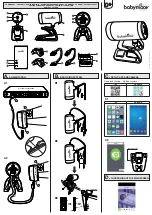
7
Communications
This terminal is equipped with three ports. The two serial ports are
intended for connection to either a host/modem or a serial printer. The
remaining port is a Centronics-compatible printer port. The port you use as
the printer port depends on whether you have a serial or a parallel interface
to the printer. Another factor affecting your port selection is your choice of
connecting the terminal to one or two host computers.
The first host/printer serial port (SES1-EIA) can communicate with your
computer or printer at a baud rate of 110 to 134,400 baud (bits per
second). The second host/printer serial port (SES2-AUX) can communicate
at speeds from 110 baud to 38,400 baud. Either port can be used to
connect to a host computer/modem or serial printer.
In single host mode, you have the choice to use the second serial port or to
use the parallel printer port, as your printer interface. In dual host mode,
the natural choice is to use the parallel port, although other options are
available (See the “Installation” chapter). Refer to the following sections for
further information on these ports.
Receive Flow Control
Because devices can receive data faster than they can process it, data flow
control (selectable in the PORTS menu of Setup) should be used to prevent
data loss. Software flow control relies on the Xon and Xoff characters (“g”
and “e” characters in Scan Code Key mode) to indicate when the terminal is
able or unable to store further data. The Xon signal transmits the DC1
character (11h) and the Xoff signal transmits DC3 (13h).
The terminal’s receive buffer can store 1024 bytes (characters). When “EIA
(or Aux) Rcv” in the Setup menu for PORTS is “Xon-Xoff,” the terminal
issues an Xoff character, indicating to the host that it should stop
transmitting data. The terminal will then continue to process data until its
receive buffer is empty. It will then issue an Xon character to the host,
indicating that it can resume sending data to the terminal.
If the “EIA (or Aux) Rcv” is “No Protocol” in Setup, the terminal will
continue to accept characters into its receive buffer until it is full.
Additional characters will be lost. Xon-Xoff protocol must also be set on
the host computer or printer for proper handshaking.
In addition to software “receive” flow control (Xon-Xoff), the serial
host/printer ports support “receive” hardware flow control. The SES1-EIA
port has an outgoing DTR (Data Terminal Ready) signal. If “EIA Rec” is “DT”
in Setup, and the terminal’s receive buffer fills to the level mentioned above,
the terminal will set the DTR signal low to inform the (serial) host device to
stop sending data. On the SES2-AUX port, the incoming DSR (Data Set
Ready) signal serves to signal the host (serial) device that the terminal is not
ready to receive more data, if “Aux Recv” is “DSR” in Setup.
Содержание InfoWindow II 3153
Страница 1: ...User s Guide InfoWindow II 3153 ASCII Display ...
Страница 84: ...67 ...
Страница 85: ......
Страница 89: ...71 Printed in the U S A 25H2137 598 0009201 ...
















































